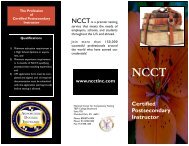P.A.C.E.® Approved COURSE DESCRIPTION - National Center for ...
P.A.C.E.® Approved COURSE DESCRIPTION - National Center for ...
P.A.C.E.® Approved COURSE DESCRIPTION - National Center for ...
Create successful ePaper yourself
Turn your PDF publications into a flip-book with our unique Google optimized e-Paper software.
6. How many blood draws and injections are estimated to be per<strong>for</strong>med daily in the<br />
United States?<br />
a. 9,000<br />
b. 1,000<br />
c. 190,000<br />
d. 900,000<br />
7. Which of the following is the most common <strong>for</strong>m of needle phobia?<br />
a. Acute sensitivity to pain<br />
b. Classic needle phobia<br />
c. Fear of the unknown<br />
d. Vasovagal reflex reaction<br />
8. Which of the following is a symptom of a vasovagal reflex reaction?<br />
a. Extreme sensitivity to pain<br />
b. Fainting (syncope)<br />
c. Skin rash<br />
d. Tachycardia (rapid heart beat)<br />
9. What percentage of needle phobic patients have a first-degree relative with a needle<br />
phobia?<br />
a. 8%<br />
b. 28%<br />
c. 68%<br />
d. 80%<br />
10. Which of the following is NOT a clinical finding seen when a needle phobic<br />
patient is exposed to a needle?<br />
a. Abnormal electrocardiogram results<br />
b. Decrease in stress hormones<br />
c. Nausea<br />
d. Sweating<br />
11. Needle phobia is thought to have an inherited and __________ component.<br />
a. familial<br />
b. genetic<br />
c. inborn<br />
d. learned<br />
12. Both needle phobic patients and healthcare providers must communicate<br />
effectively to assure the most appropriate care is given.<br />
a. True<br />
b. False<br />
Page 16 of 19



